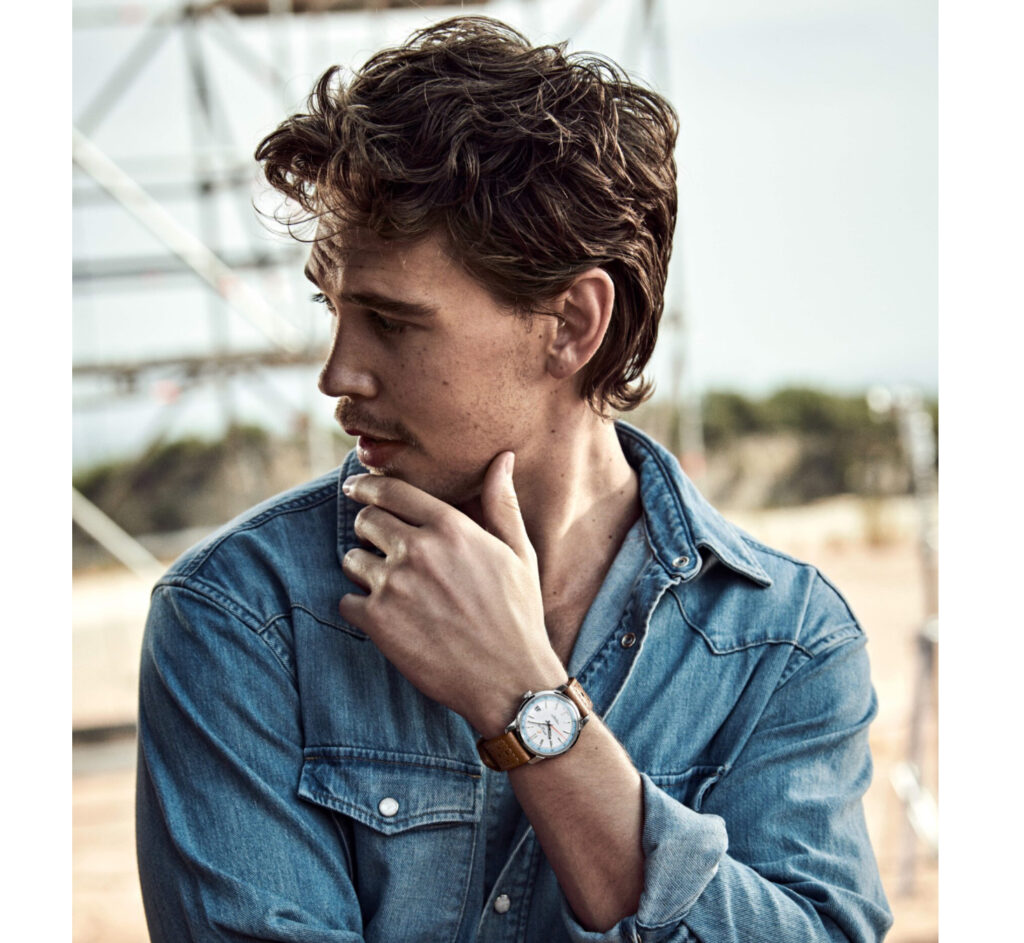By trade, actors disappear. Their task is to vanish into character, to become someone else entirely. It’s a talent that Austin Butler has refined with such discipline and ease that we now expect him to carry entire histories on his back, often before he’s even uttered a word on screen. Whether he’s wearing the rhinestone suits of Elvis Presley, navigating the arid futurism of Dune: Part Two, or thundering across American roads in The Bikeriders, Butler commands not only the camera—but time itself.
And now, in a turn that’s as symbolic as it is stylish, Butler partners with Breitling, joining the Swiss watchmaker’s Top Time collection as its newest brand ambassador. This isn’t a costume. It’s a reflection. The man who has portrayed icons now stands as one—not through imitation, but through quiet authority.
Who Is Austin Butler?
Born in Anaheim, California, in 1991, Butler’s story is one of the rarest in Hollywood: slow-burn, steady, and entirely on his own terms. He emerged not from blockbuster franchises or the Broadway fast track, but from a series of modest TV roles that, in retrospect, seem like backdrops preparing him for future spotlight.
Those early roles—in Zoey 101, Switched at Birth, and The Carrie Diaries—hinted at an actor in search of range. But it wasn’t until 2019, when he landed the lead in Baz Luhrmann’s Elvis, that the industry began to understand the gravity of his focus. His embodiment of the King of Rock and Roll was not mimicry. It was transcendence—a performance that garnered a BAFTA, a Golden Globe, and an Academy Award nomination, while cementing his place on the international stage.
Since then, Butler has moved carefully. Roles in Masters of the Air and Dune: Part Two show a performer unafraid to dive into vastly different textures—whether it be the dark intensity of Feyd-Rautha or the haunting nobility of a World War II pilot. There is a pattern here: every character he plays wrestles with time, legacy, and consequence.
Perhaps it was inevitable, then, that Butler would align with a brand whose own identity is woven through decades of horological heritage.
Breitling’s Top Time: Designed for the Free-Spirited
The Breitling Top Time collection debuted in the 1960s—a decade of radical shifts, artistic rebellion, and a new cultural obsession with velocity. Originally created to speak to a younger generation of professionals and sportsmen, Top Time wasn’t about the boardroom—it was about the road. Bold dials, sleek profiles, and a sense of motion built into every detail.
Now, more than half a century later, Top Time has evolved, reimagined for a modern audience that still values movement, but now with an added layer of legacy. And into this narrative steps Austin Butler.
Sporting the new Top Time B31, which houses Breitling’s first three-hand manufacture movement, Butler represents not just a face, but an ethos. Like the Top Time, he blends classic sensibility with a hunger for reinvention. He’s not here to perform. He’s here to live it.
A Meeting of Craft: Actor and Horologist
What makes this partnership more than just a photoshoot is how seamlessly Butler and Breitling align in terms of craft. Both are built on layers. Both require patience. Both demand an obsession with detail.
The Top Time B31—Butler’s watch of choice—features a COSC-certified chronometer-grade movement developed entirely in-house by Breitling. A feat of precision and performance, the watch is not only aesthetic, but deeply engineered for experience. Its clean face, bold markers, and elegant subdials harken back to its mid-century roots, while its internals belong firmly to the present.
Similarly, Butler’s performances are never surface. In every role, he disappears for months—studying dialect, gesture, emotional cadence—until character and man become one. His work in Elvis required voice training so rigorous he didn’t speak in his natural voice for nearly three years. For The Bikeriders, he immersed himself in the customs and code of 1960s motorcycle gangs. For Masters of the Air, he trained like a pilot, learning not just lines but weight, consequence, sacrifice.
In both actor and watchmaker, the principle remains the same: authenticity demands labor. It must be built. Lived. Measured.
Time as Storytelling
It’s fitting that Butler’s collaboration with Breitling revolves around the idea of time—not just in the mechanical sense, but as a symbol of legacy. In film, time is manipulated. In watches, it is mastered. For Butler, whose roles often intersect with cultural memory, time is material—something to be shaped, worn, challenged.
His characters—Elvis, Feyd-Rautha, Major Gale “Buck” Cleven—are men living at the edge of time. They face mortality, historical change, or the pressure of legacy. Each performance is a study in how people carry the weight of their eras. This sensibility makes Butler the ideal Top Time ambassador—not just a wearer of watches, but a carrier of moments.
The Look of Now
Style is never an afterthought in a Breitling campaign, and Butler delivers with cool precision. The visuals accompanying the Top Time launch show him relaxed but assertive—denim shirts, tailored leather, suede bombers—evoking Steve McQueen grit with a 21st-century inflection. He doesn’t pose. He inhabits.
This sartorial fluency is another area where actor and brand align. Breitling has long partnered with icons whose wardrobes are as compelling as their achievements. From James Bond to Formula 1 legends, the brand understands that watches are not just tools—they’re identity signifiers.
In this sense, Butler’s casting isn’t just smart. It’s strategic. He appeals across generations: to classicists who appreciate craftsmanship, and to younger audiences who admire authenticity over status.
From Role to Reality
The story doesn’t end on screen. As Butler steps into his role as Breitling’s ambassador, the lines between performance and person begin to blur. His presence at watch events, interviews with horology publications, and off-duty photos all reinforce the same image: a man in motion, aware of the past, unafraid of the future.
In today’s luxury landscape, where brand partnerships often feel transactional or hollow, this one carries weight. Butler doesn’t represent the Top Time as an accessory—he represents it as a philosophy. One of movement, elegance, and quiet rebellion.
A Timepiece for a Time-Maker
In the end, what makes Austin Butler such a compelling figure—whether in cinema or in fashion—is his ability to slow down the frame. There’s a moment before he speaks, before he lands a trick, before he walks into the shot—that feels like suspended time. That is the essence of a watch. That is the essence of the Top Time.
Breitling could have chosen anyone. But in selecting Butler, they’ve chosen not just a face, but a story. A young man who listens to the silence between the ticks. Who understands that greatness isn’t just built—it’s timed.
Time, Recast
Austin Butler’s partnership with Breitling marks more than just a campaign. It’s a confluence of art, precision, and purpose. As his star continues to rise, Butler does not simply follow time—he shapes it. And as Breitling continues to push the limits of watchmaking while honoring its roots, it finds in Butler a mirror, a muse, and a kindred spirit.
No comments yet.









